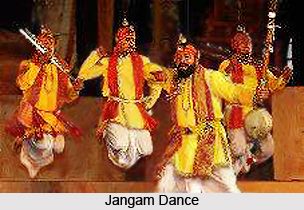 Jangam is an Indian folk dance performed in the honour of Lord Shiva. Those who perform this traditional dance are called Jangam dancers. The term Jangam has been derived from the movable emblem of Lord Shiva.
Jangam is an Indian folk dance performed in the honour of Lord Shiva. Those who perform this traditional dance are called Jangam dancers. The term Jangam has been derived from the movable emblem of Lord Shiva.
History of Jangam
Jangam is a sub-caste of the Lingayat (Veerashaiva) community. The Jangams migrated from Karnataka and Andra Pradesh states of India in order to disseminate the Shaivaite cult and to act as priests for those who do not avail the services of Brahmans for performing religious rites.
Performance of Jangam Dance
While performing Jangam dance, the dancers recite verses on the mythological marriage of Siva and Parvati. The recitation is done in a ritualistic hypnotic monotone. As performers, they entertain people during religious and social festivals in the obscurity of the villages.
Their dramatic presence is heightened by their headgear, a brass band with the image of a snake and peacock feathers flashing in the air. Their narrative and rhythmic movement is embellished by bells, gongs, manjim or cymbals, and chhenna or percussion sticks, weaving the most incredible musical patterns. Presently, forced into penury by the loss of rural audiences to mass media, they are reduced to begging for alms.
This article is a stub. You can enrich by adding more information to it. Send your Write Up to content@indianetzone.com



















